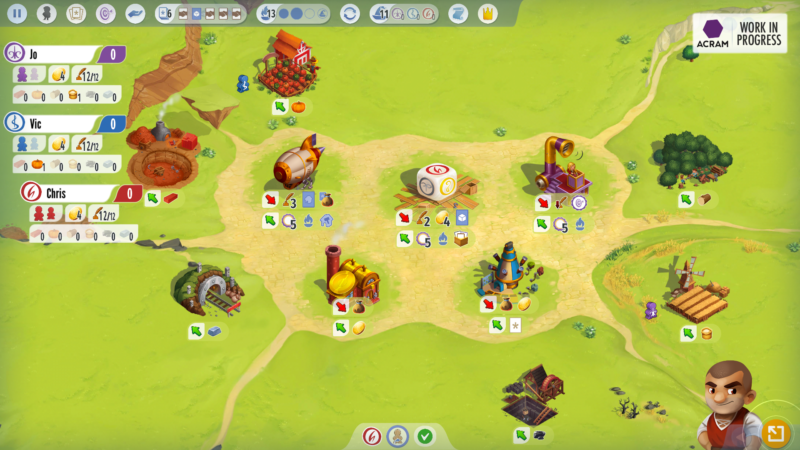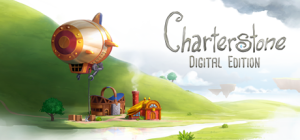
Charterstone has been one of the most popular "legacy" board games since that style of game first emerged. (A legacy game alters rules and board state permanently across multiple playthroughs, often based on an overarching storyline.) It's also a standalone legacy game, not an extension of previous brands, like Pandemic (the massive hit), Risk (the original), and Machi Koro (the unnecessary).
Acram Digital just released its digital adaptation of Charterstone (read our review of the tabletop version), and it's a strong one, with outstanding graphics and competitive AI players—but a very crowded screen that, on Steam at least, made it hard to see the entire board.
The game is coming to Steam on March 26, with ports on Android, iOS, and Nintendo Switch going live shortly thereafter.
Building your charter

Charterstone itself is a classic worker-placement game. You start with two meeples, which you can place on the board to use buildings or gain resources, to build new buildings, or to open "crates" that add cards and rules to the game itself. The ultimate goal across the twelve-game story is to earn the most victory points, but within each game you might make choices that are less beneficial in the short term but help more in the long term. The buildings you place on the board are stickers, and they can cover up other buildings, so the board itself changes over the course of the game.
From game to game, you'll carry over some things you gain (gold, resources, cards); after any game where you don't win, you increase your capacity to carry these things over by one. You also gain "glory" based on the points you score in each game, and when you achieve enough glory, you can cash it in for a specific reward at the start of the next game. The buildings themselves let you construct a points engine of sorts, although some rules that emerge as the game progresses make that a little less straightforward.
Acram's digital port of Charterstone takes the fun, bright graphics of the physical game and adds some quirky animations to liven things up, while really speeding up gameplay. I could do without the extra visuals when players open a crate, which introduces two or more new cards to the game, often with new rules; you need to see everything, but the way it plays out on screen isn't smooth or intuitive. The other animations, however, don't get in the way and often help illustrate what's happening.
And there's a lot happening in this game, with exchanges of some sort happening on nearly every turn. I found even the medium AI players to be more than competent, and I wish it was easier to go back and see what they had done so I could improve my own strategy. (That may be a statement on my own skill level, of course). AI players also take their turns extremely quickly, so for a game that can have some significant downtime at the table—especially when one player triggers something like income that affects every player—the digital port moves along quite well in local vs AI mode.
If you haven't played Charterstone on tabletop, it's a large board with a lot of information on it by the fourth or fifth game. There are six "charters," each of which can house six buildings, and some of those change each game; add the six communal buildings in the center and you have 42 buildings you can use in just about every game. That's a lot of cognitive load for players even on the table, but at least there you can quickly scan the entire board and get a quick sense of your options.
The app handles this about half right: when you select a meeple, any buildings you can't use will darken, so the buildings you can use are easier to see. However, on Steam there wasn't an easy way to pan quickly or to zoom in/out, and I would often overlook—or just forget—what options were available to me in each game. Acram did do well by moving some information, like the display of advancement cards, the progress track, the reputation track, and the public objective cards, to the top row of the screen, just showing the number of spaces remaining where relevant. You can click on those to get the full display; if you get private objective cards later in the game, you need to open the objective card display and scroll right.
If you enjoyed the tabletop version of Charterstone as I did, you'll like the app. I'm far more likely to play this than to buy another copy of Charterstone (or the recharge pack, which lets you play the game again) and go through that 12+ hour time investment once more, even though I think the game is great. The pre-release version on Early Access did have some tiny glitches, like showing error codes at the bottom of the screen, but nothing that affected gameplay, and I'd still recommend this adaptation. It also allows you to play single games, using your own completed board or randomly generated maps, so the replay value here is quite high. And if you've never played the physical game, I think this app might convince you to give it a shot.
https://arstechnica.com/gaming/2020/03/review-with-charterstone-a-legacy-game-goes-digital/
2020-03-21 12:00:00Z
CBMiW2h0dHBzOi8vYXJzdGVjaG5pY2EuY29tL2dhbWluZy8yMDIwLzAzL3Jldmlldy13aXRoLWNoYXJ0ZXJzdG9uZS1hLWxlZ2FjeS1nYW1lLWdvZXMtZGlnaXRhbC_SAQA
Bagikan Berita Ini














0 Response to "Review: With Charterstone, a “legacy” game goes digital - Ars Technica"
Post a Comment